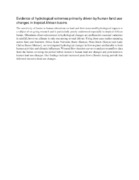| dc.contributor.author | Odongo, Vincent | |
| dc.contributor.author | Kambombe, Oscar | |
| dc.contributor.author | Mutua, Benedict M. | |
| dc.contributor.author | Oel, Pieter van | |
| dc.contributor.author | Ajwang, Rispah | |
| dc.contributor.author | Kitaka, Nzula | |
| dc.date.accessioned | 2019-05-13T17:59:48Z | |
| dc.date.available | 2019-05-13T17:59:48Z | |
| dc.date.issued | 2018-04 | |
| dc.identifier.uri | http://erepository.kibu.ac.ke/handle/123456789/956 | |
| dc.description.abstract | The sensitivity of basins to human alterations on land and their associated hydrological impacts is a subject of on-going research and is particularly poorly understood especially in tropical African basins. Oftentimes observed extremes in hydrological changes are attributed to seasonal variations in rainfall; however, climate is only one among several drivers. Using three case studies spanning across East and Southern Africa (Lake Naivasha Basin (Kenya), Mara Basin (Kenya) and Lake Chilwa Basin (Malawi), we investigated hydrological changes in flow regimes attributable to both human activities and climatic influences. We used flow duration curves to analyze streamflow data from the basins covering the period before intensive human land use changes and post intensive human land use changes. Our findings indicate increased peak flows (floods) during periods that followed intensive land use changes. | en_US |
| dc.language.iso | en | en_US |
| dc.rights | Attribution-NonCommercial-ShareAlike 3.0 United States | * |
| dc.rights.uri | http://creativecommons.org/licenses/by-nc-sa/3.0/us/ | * |
| dc.title | Evidence of hydrological extremes primarily driven by human land use changes in tropical African basins | en_US |
| dc.type | Article | en_US |

